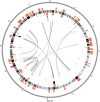Comparative Genomics Reveal the Animal-Associated Features of the Acanthopleuribacteraceae Bacteria, and Description of Sulfidibacter corallicola gen. nov., sp., nov
- PMID: 35173698
- PMCID: PMC8841776
- DOI: 10.3389/fmicb.2022.778535
Comparative Genomics Reveal the Animal-Associated Features of the Acanthopleuribacteraceae Bacteria, and Description of Sulfidibacter corallicola gen. nov., sp., nov
Abstract
Members of the phylum Acidobacteria are ubiquitous in various environments. Soil acidobacteria have been reported to present a variety of strategies for their success in terrestrial environments. However, owing to lack of pure culture, information on animal-associated acidobacteria are limited, except for those obtained from 16S rRNA genes. To date, only two acidobacteria have been isolated from animals, namely strain M133T obtained from coral Porites lutea and Acanthopleuribacter pedis KCTC 12899T isolated from chiton. Genomics and physiological characteristics of strain M133T and A. pedis KCTC 12899T were compared with 19 other isolates (one strain from each genus) in the phylum Acidobacteria. The results revealed that strain M133T represents a new species in a new genus in the family Acanthopleuribacteraceae. To date, these two Acanthopleuribacteraceae isolates have the largest genomes (10.85-11.79 Mb) in the phylum Acidobacteria. Horizontal gene transfer and gene duplication influenced the structure and plasticity of these large genomes. Dissimilatory nitrate reduction and abundant secondary metabolite biosynthetic gene clusters (including eicosapentaenoic acid de novo biosynthesis) are two distinct features of the Acanthopleuribacteraceae bacteria in the phylum Acidobacteria. The absence of glycoside hydrolases involved in plant polysaccharide degradation and presence of animal disease-related peptidases indicate that these bacteria have evolved to adapt to the animal hosts. In addition to low- and high-affinity respiratory oxygen reductases, enzymes for nitrate to nitrogen, and sulfhydrogenase were also detected in strain M133T, suggesting the capacity and flexibility to grow in aerobic and anaerobic environments. This study highlighted the differences in genome structure, carbohydrate and protein utilization, respiration, and secondary metabolism between animal-associated acidobacteria and other acidobacteria, especially the soil acidobacteria, displaying flexibility and versatility of the animal-associated acidobacteria in environmental adaption.
Keywords: Acanthopleuribacteraceae; Sulfidibacter corallicola; animal acidobacteria; eicosapentaenoic acid (EPA); sulfhydrogenase.
Copyright © 2022 Wang, Li, Liu, Chen, Su, Liang, Huang and Yu.
Conflict of interest statement
The authors declare that the research was conducted in the absence of any commercial or financial relationships that could be construed as a potential conflict of interest.
Figures


Similar articles
-
Acanthopleuribacter pedis gen. nov., sp. nov., a marine bacterium isolated from a chiton, and description of Acanthopleuribacteraceae fam. nov., Acanthopleuribacterales ord. nov., Holophagaceae fam. nov., Holophagales ord. nov. and Holophagae classis nov. in the phylum 'Acidobacteria'.Int J Syst Evol Microbiol. 2008 Nov;58(Pt 11):2597-601. doi: 10.1099/ijs.0.65589-0. Int J Syst Evol Microbiol. 2008. PMID: 18984699
-
Genomic insights into the Acidobacteria reveal strategies for their success in terrestrial environments.Environ Microbiol. 2018 Mar;20(3):1041-1063. doi: 10.1111/1462-2920.14043. Epub 2018 Mar 12. Environ Microbiol. 2018. PMID: 29327410 Free PMC article.
-
Novel isolates double the number of chemotrophic species and allow the first description of higher taxa in Acidobacteria subdivision 4.Syst Appl Microbiol. 2015 Dec;38(8):534-44. doi: 10.1016/j.syapm.2015.08.001. Epub 2015 Sep 28. Syst Appl Microbiol. 2015. PMID: 26460220
-
Pyrinomonas methylaliphatogenes gen. nov., sp. nov., a novel group 4 thermophilic member of the phylum Acidobacteria from geothermal soils.Int J Syst Evol Microbiol. 2014 Jan;64(Pt 1):220-227. doi: 10.1099/ijs.0.055079-0. Epub 2013 Sep 18. Int J Syst Evol Microbiol. 2014. PMID: 24048862
-
Genomic Analysis of Family UBA6911 (Group 18 Acidobacteria) Expands the Metabolic Capacities of the Phylum and Highlights Adaptations to Terrestrial Habitats.Appl Environ Microbiol. 2021 Aug 11;87(17):e0094721. doi: 10.1128/AEM.00947-21. Epub 2021 Aug 11. Appl Environ Microbiol. 2021. PMID: 34160232 Free PMC article.
Cited by
-
An update on novel taxa and revised taxonomic status of bacteria isolated from aquatic host species described in 2022-2023.J Clin Microbiol. 2024 Nov 13;62(11):e0104324. doi: 10.1128/jcm.01043-24. Epub 2024 Oct 24. J Clin Microbiol. 2024. PMID: 39445811 Free PMC article. Review.
-
Characterization of intra-tumoral microbiota from transcriptomic sequencing of Asian breast cancer.Sci Rep. 2025 Aug 24;15(1):31147. doi: 10.1038/s41598-025-15877-x. Sci Rep. 2025. PMID: 40850975 Free PMC article.
References
LinkOut - more resources
Full Text Sources
Molecular Biology Databases
Research Materials
Miscellaneous

